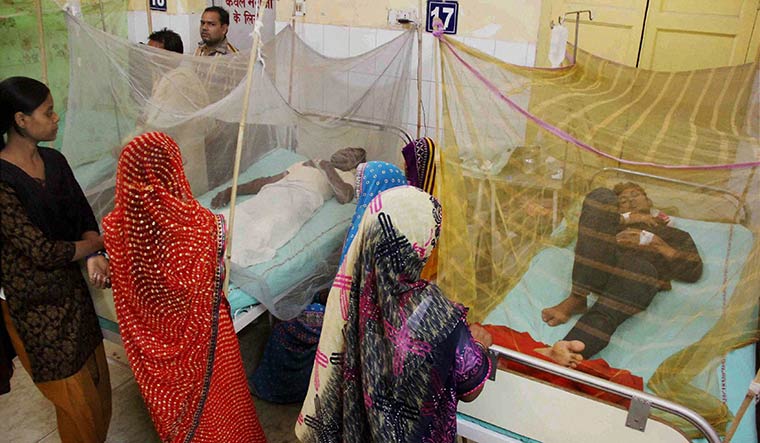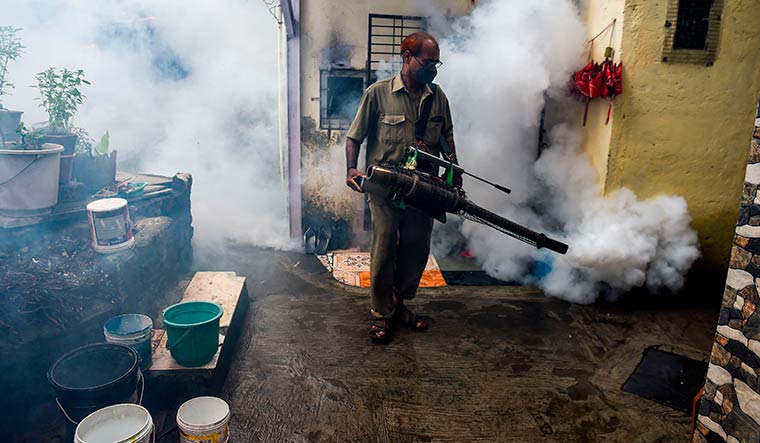It has killed more people world over than wars have. So, when India registered a decline in the number of malaria cases, it became an obvious reason to cheer. The optimism in certain policy quarters and nonprofit organisations working on the disease has been palpable. After all, not too long ago, India was among the top three countries leading in the number of malaria cases. In 2017 though, the country managed to register a 24 per cent decline in new cases (according to the World Malaria Report, 2018). Odisha, which has 40 per cent of the malaria cases in the country, saw a staggering 80 per cent fewer cases. The malaria burden has also declined by over 80 per cent between 2000 and 2018 (from 2.03 million cases to 0.39 million), and malaria deaths by over 90 per cent (from 932 deaths to 85).
Even as scientists and public health experts grapple with more confounding disease outbreaks such as those caused by dengue, Zika and Nipah viruses, the malaria front has looked promising. In that context, the government's target to completely fend off the scourge of the deadly single celled malarial parasite by 2030 (zero indigenous cases) also seems achievable. Well, almost.
Fiindings from the MalaFA (Malaria Futures for Asia) report released in Bangkok in April suggest that while there is much to celebrate, roadblocks await us, too. The report, commissioned by Novartis Social Business, reflects views of 36 policymakers in India and four south-east Asian countries (Cambodia, Myanmar, Thailand and Vietnam).
In India, experts working on malaria felt a “high level of optimism”, especially among state-level functionaries from Odisha and Assam, as opposed to their counterparts in the Union government, in achieving the 2030 malaria target, the report said. This optimism, however, was restricted to eliminating plasmodium falciparum, one of the two more common malarial parasites in the region (the other one is plasmodium vivax). Indian respondents, particularly in Odisha and Assam, also felt that the country had political commitment for malaria elimination, and at least state-level funding was not a problem.
However, the report recorded caveats, too. India's malaria success story could get marred by grim ground realities such as a “lack of infrastructure, availability of trained manpower, access to diagnostic kits, treatment failure” and the looming threat of drug resistance.
“The study is meant to guide domestic and donor commitments towards malaria elimination in the face of increasing challenges. The findings will help countries such as India, which are fighting the rising burden of non-communicable diseases as well as a disease such as malaria, towards the best use of their resources. We also need to know what are the best practices that can be scaled up, and how best we can engage and educate those on the ground,” said Deborah Gildea, head Novartis Social Business Asia. The nonprofit, which has been working on strengthening primary care in India, is now planning to expand to 40 villages in Odisha and work on malaria awareness among other public health issues, said Gildea.
While Odisha has registered success in bringing cases down, it is important that other states, especially high endemic ones, do so, too. “Other states with a high malaria burden also need to exhibit the same level of political will and professional skill,” said Dr K. Srinath Reddy, director, Public Health Foundation of India, and co-chair of the MalaFA report.
The big point that the report and experts are making is that given our history of the fight against malaria, we can’t afford to be laidback. “Despite a successful malaria control programme launched in 1953, there was a resurgence of the disease in the 1960s and 1970s. This was the result of technical, financial and operational problems,” said Dr Manju Rahi, senior scientist at the Indian Council of Medical Research. “In the late 1960s malaria cases in urban areas started to multiply, and upsurge of malaria was widespread. Government efforts led to a decline by 1987, but by 1996, there was a surge again. The eradication goal was officially shelved and the programme was changed to National Anti-Malaria Programme in 1997.” The annual case load, though steady around two million cases in the late 1990s, has shown a declining trend since 2002. Malaria control interventions have also been scaled up after the launch of National Framework for Malaria Elimination in February 2016. “But we must not be fooled by the recent decline, because in the past too, we have seen that the cases went down, and then the disease came back,” said Rahi.
In April, the ICMR launched the Malaria Elimination Research Alliance India, bringing together several organisations, including funding bodies, working on the disease under one platform to streamline research efforts, develop new solutions and avoid duplication. Such an effort is warranted because in the run-up to India's “malaria-free” status by 2030, the government has its milestones defined—by 2022, 26 states are targeting eliminating malaria; by 2024, all states are to reduce the annual parasite incidence to less than 1 per 1,000 people, and in the next three years, all states should have interrupted indigenous transmission.
Though it is known that certain efforts such as preventive techniques, mass screening and better diagnostics have worked, researchers need to introspect what exactly has worked on the ground, said Rahi. “We know that the use of long-lasting insecticide nets (LLINs) has worked. Not only do these nets have direct benefits of protecting people against the malaria mosquito, it also has indirect benefits in that those outside the nets are also protected because it stems the transmission of the parasite,” she said. “But the question is what after these nets—issues such as how to dispose it.”
Those interviewed in the report also highlighted the challenges in preventing the disease in remote jungles, hilly terrains, tribal areas, city slums, large cultivated lands and rice paddies, and issues with proper treatment and diagnosis. “The challenge is: do I have a qualified technician with a working microscope at every public centre? Do I have mobile people at the sub centre level who can go from house to house taking samples,” the report quoted an interviewee, highlighting the lack of trained health care workers.
Another set of interviewees cited the lack of training among ASHA workers, who, they said, were at times unable to provide proper treatment and ensure the patient stuck to the medication regime.
“We need to ensure the availability of expertise, which calls for investments in training, especially in primary health care,” said Reddy. “Rapid diagnostic kits are essential and should be widely available. More than research, surveillance systems need to be strengthened. Our surveillance systems are weak and produce conflicting estimates. District-level malaria maps are essential for guiding and evaluating intensive efforts in programme implementation for elimination.”
Rahi said there are other challenges in the fight against malaria— asymptomatic malaria and the threat of drug resistance from across our borders. As countries such as Thailand are already seeing cases of drug resistance, India, though untouched by drug resistance, needs to be alert and prepared. “For us, the northeast is the corridor for the drug-resistant malarial parasite from the Greater Mekong region (Cambodia, China, Laos, Myanmar and Vietnam) to reach us,” said Rahi. Detecting asymptomatic low-density malaria—where the concentration of the parasite is too low—will constitute the next challenge, she said.
For a country such as India, the challenge is even greater. A new vaccine against plasmodium falciparum that is being celebrated as the world's first against malaria does not hold much promise for India. “The vaccine has only 40 per cent efficacy and has to be re-administered, too. For a low resource country such as ours, it won’t make sense at all,” said Dr Raman Gangakhedkar, senior scientist, ICMR. Besides, as Gangakhedkar and Rahi contend, developing a vaccine against malaria poses an inherent challenge because the organism is complex, as is the mosquito, of which different varieties survive in different ecosystems.
In the face of such challenges, Rahi said we ought to be prepared at all fronts—better diagnostics, surveillance and new drug development, too.
But in India, given the absence of drug resistance to artemisinin combination therapy, used to treat malaria caused by p. falciparum, simple strategies are more relevant. As the report defines, we are looking for lessons from Odisha—mass screening, diagnosis for all fevers, treating asymptomatic malaria, and use of LLINs. “Ultimately the answer will lie in strengthening primary health care,” said Gildea.
In low endemic states, elimination of malaria is a low hanging fruit, experts say. “By next year, 15 states are targeted to achieve elimination, which is doable. The high endemic states will be challenging. Funding for LLINs from the Global Funding for TB, HIV/AIDS and Malaria has ended, but the government is confident that money won’t be a problem,” said Rahi. “If a highly populous country such as China can do it, our neighbour Sri Lanka can do it, we can’t be left behind.”



